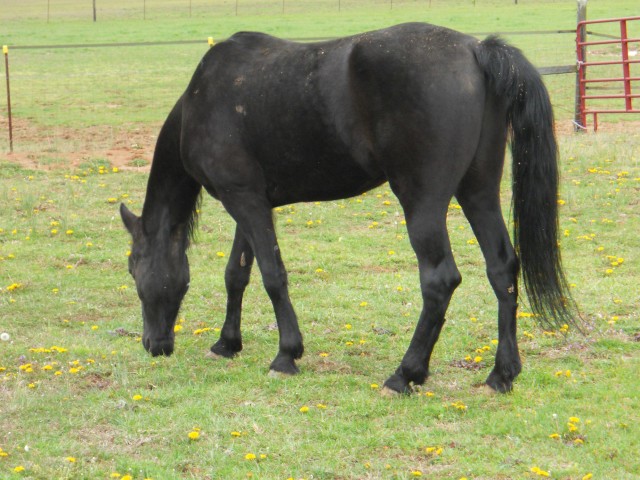
Saving Theo: A Horse At Last
Candace Wade follows first-hand the rehabilitation of Theo, a former “Big Lick” Tennessee Walking Horse. Today, Theo explores the singularly equine pleasures of turnout time.
Let’s agree for simplicity’s sake that a horse is a hooved plant eater. They are slow grazers and are wired to keep on the move. They are designed to explore and roam. Prolonged confinement is not a natural life for a horse and may compromise its physical and mental health.
It is logical that the years of confinement, which seem to be required of “Big Lick” (on stacked shoes) performance Tennessee walking horses, can result in a lack of the consistent exercise required to build and/or maintain healthy muscle on a horse. Lack of experience in the natural world and no interaction with members of the herd can create large gaps in a horse’s world view education.
A “quick-spin-around-the-arena” performance provides limited exposure to the sights and sounds of the world with which a healthy horse must learn to cope. Birds, wind and dandelions that bloom in the field can be a mystery … and scary.
Theo’s first outing
Ed (Theo’s rescuer) told me about Theo’s first free roam – OUTSIDE — in his own small paddock. His response was “Eee Gad!”
If Theo had been confined in a small stall (possibly for 10+ years), with short walks to the arena distracted by action devices and aggressive bits, he may not have had the opportunity to process the showground golf carts, trucks with trailers, etc. that were his scene for years.
Now, the natural world yawned before him teeming with new sights and sounds. He was unfettered and free to notice and react to swaying trees, stacked hay bales, a strolling cat or an open gate. The riding mower way, way down in the field so startled him he jolted and sprinted to the safety of furthest corner of his small paddock. Ed allowed Theo to get used to the natural world. The urge to graze surpassed his concern, so, finally, Theo grazed.
My observations
Ed led a handsome, relaxed black horse from the barn to a small paddock thick with grass and bright with violets. Intent on grazing, the horse ignored the rest of the herd nearby. The horse was Theo. Theo was a horse.
What can I say? Theo nosed the grass and chomped. Perfect. That’s what a horse is supposed to do, right? Ed and I went to retrieve him after a couple of hours. He was a calm, blasé horse until I made a clucking sound. Theo jumped. Ed explained the clucking sound is the sound used in the show ring to encourage faster movement. I won’t use that sound again.
Little lessons, big results
Every activity is an education and Theo seems quick to meet the challenge. I could see him anticipating each stop and start that Ed made while leading Theo. He caught on that his place was Ed’s shoulder. He agreed to take one step closer when Ed encouraged him to join up. It was a game.
Once in his new, larger stall, Theo could roam. He tended to hang out at the back wall — Ed explained that Theo used to turn his back, but now keeps his side open; this position seems to show that he is better able to accept what might come at him. He doesn’t need to “play opossum” as it were because nothing upsetting has come at him for at least eight or nine months.
Ed explained that Theo is at what we’d call the teenage stage of testing behavioral boundaries: he’s a horse. He’s big. Not allowing him to get away with pushy or stubborn behavior is crucial at this stage. Feeling sorry about what might have happened to Theo does him a disservice. He must mind Ed as would any other horse — Theo is not allowed to ignore him; he’s not allowed to hide in the corner or turn his back to Ed when Ed is in his stall. Ed moved Theo around the stall with a kind voice and body pressure. Consistent “giving” to pressure was rewarded with a cookie.
Theo’s life as a performer required neck tension. He needs flexibility to be a horse. It’s a corny label, but I watched Ed encourage Theo in a kind of horse yoga, also known as “carrot stretches.” A cookie was held at the withers on either side; Theo had to bend to reach the cookie. Ed held a cookie inside each opposite front leg. Theo stretched to reach it. He’s much more flexible than the first time I met him. I was thrilled to see him bend his serpentine neck so willingly.
Theo’s health
Well, he looks gorgeous. Being able to graze will help his muscle tone, but his feet must heal before he can enjoy more exercise. I asked about the scarred white notch that Theo sported on his ear since his rescue. Only Theo knows and he’s mum on his scars.
Theo’s feet are still in poor shape, but he’s having a happy horsey life. Horses live in the moment: what was, or may have been, is old news for Theo. Being a horse seems to suit him. I have high hopes for Theo, but as Ed points out, each “today” is so much better than his past yesterdays. He and we are content with that.
Theo is almost zen about strolling outside to munch now. His new, larger stall gives him space to spread out. He even enjoys a good roll in the shavings. Theo is now a (mostly) calm, inquisitive grazer. Theo is a horse.
Candace will continue to follow Theo’s recovery. All of Theo’s stories are tagged #SAVING THEO and can be accessed by clicking the hashtag at the top of this page.









Leave a Comment